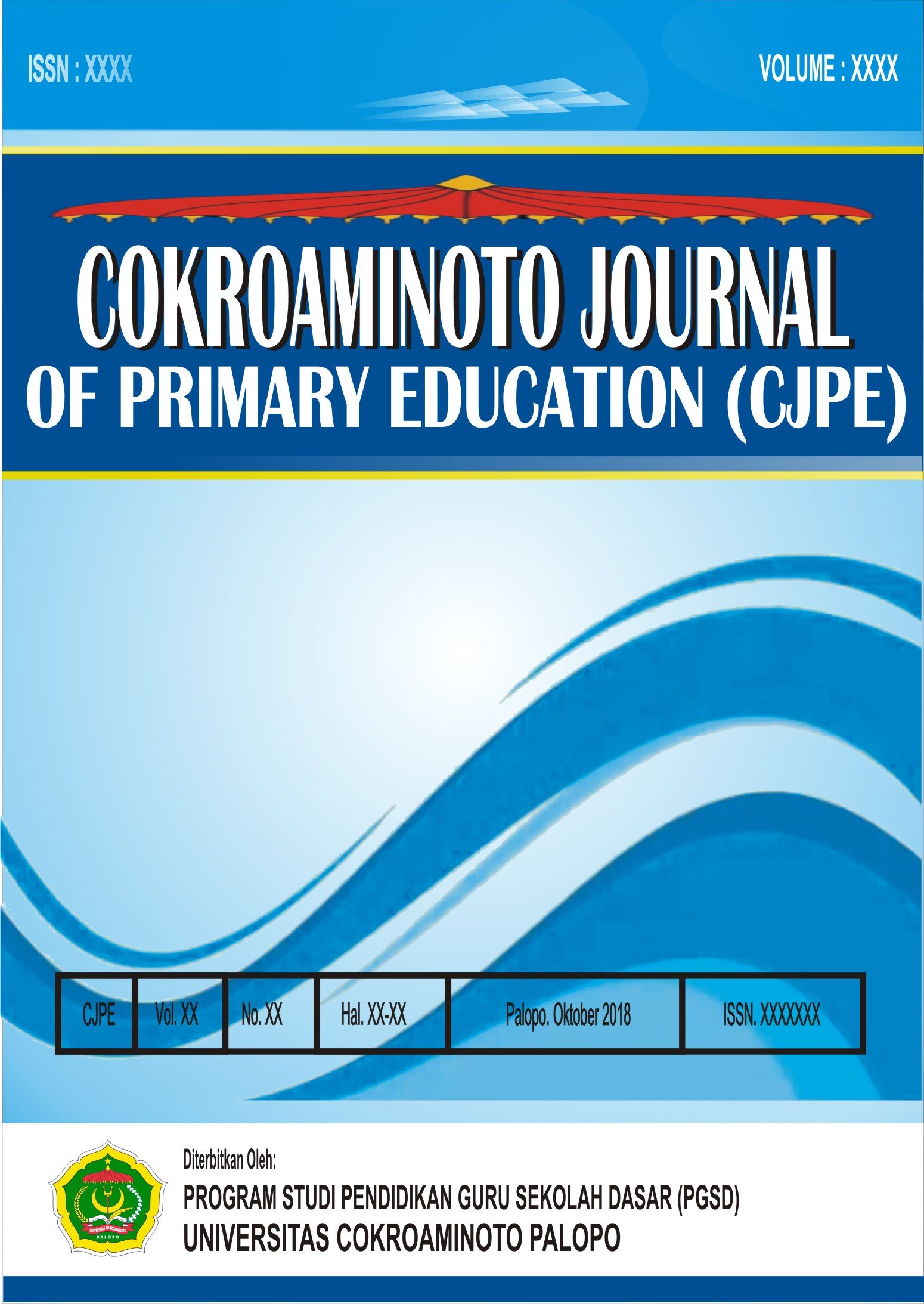Meningkatkan Hasil Belajar Siswa Melalui Penerapan Pendekatan Pemecahan Masalah (Problem Solving) pada Mata Pelajaran Matematika
DOI:
https://doi.org/10.30605/cjpe.1.1.2018.73Keywords:
Hasil Belajar, Pemecahan Masalah, Pembelajaran MatematikaAbstract
The purpose of this research is to find out the application of problem solving approaches to mathematics subjects in class V SDN 158 Watallipu and to find out the application of problem solving approaches can improve student learning outcomes. The approach used is a qualitative approach with the type of research used is Classroom Action Research (CAR). The results of the observation analysis of teacher activity in cycle I are in less qualification (K) and cycle II is in good qualification (B). The results of observations of student activities in the first cycle are in less qualification (K) and second cycle is in good qualification (B). Learning outcomes in the first cycle are in less qualification (K) because they have not reached the minimum completeness criteria caused by factors researchers lack guiding students to read story problems to completion to find out the type of problem and the researcher did not give students the opportunity to respond to the results obtained another group, because the first cycle was not successful, the study continued into cycle II with various improvements. Cycle II has an increase, namely being in good qualification (B) and has reached a predetermined indicator. The conclusion in this study is to apply the approach to problem solving (problem solving) can improve student learning processes and student mathematics learning outcomes.
Downloads
References
Depdiknas. (2006). Kurikulum Tingkat Satuan Pendidikan (KTSP) Mata Pelajaran Matematika untuk Tingkat SD/MI. Departemen Pendidikan Nasional. Jakarta.
Djamarah, S,B. (2006). Strategi Belajar Mengajar. Rineka Cipta. Jakarta.
Hamdani. (2011). Strategi Belajar Mengajar. Pustaka Setia. Bandung.
Hamzah, A, dkk. (2014). Perencanaan dan Strategi Pembelajaran Matematika. PT Raja Grafindo Persada. Jakarta
Karim, M. (2007). Pendidikan Matematika II. Universitas Terbuka. Jakarta
Kunandar. (2008). Langkah Mudah Penelitian Tindakan Kelas sebagai Pengembangan Profesi Guru. PT. RajaGrafindo Persada. Jakarta.
Mantasiah, R. (2018, June). Pay It Forward Model in Foreign Language Learning to Increase Student’s Self Efficacy and Academic Motivation. In Journal of Physics: Conference Series (Vol. 1028, No. 1, p. 012178). IOP Publishing.
Mantasiah, R., Juffri, J., & Yusri, Y. (2017). Keefektifan Model Pembelajaran Jaring Laba-Laba (Webbed) dalam Keterampilan Menulis Karangan Sederhana Bahasa Jerman. Indonesian Journal of Educational Studies, 20(2).
Marwati. (2010). Model-model pembelajaran Inovatif dan Asesmen Pembelajaran Matematika (Buku Ajar). Universitas Muhammadiyah Parepare. Parepare.
Pitajeng. (2006). Pembelajaran Matematika yang Menyenangkan. Jakarta: Departemen Pendidikan Nasional Direktorat Jenderal Pendidikan Tinggi Direktorat Ketenagaan.
Qalbi, U. N., Mantasiah, R., Jufri, J., & Yusri, Y. (2017). Efektivitas Model Pembelajaran Kooperatif Tipe Teams Games Tournaments dalam Keterampilan Menulis Bahasa Jerman Siswa Kelas XII IPA SMA Negeri 1 Bontonompo Kabupaten Gowa. Indonesian Journal of Educational Studies, 20(1).
Romadloni, A., & Mantasiah, R. Intercultural approach in foreign language learning to improve students’ motivation. Senior Editors, 61.
Sanjaya,W. (2008). Strategi Pembelajaran Berorientasi Standar Proses Pendidikan. Kencana Prenada Group. Bandung.
Sudjana, N. (2004). Dasar-Dasar Proses Belajar Mengajar. Sinar Baru Algensido Offset. Bandung.
Suprijono, A. (2013). Cooperative Learning Teori dan Aplikasi PAIKEM. Pusaka Pelajar. Yogyakarta.
Yusri, Y., Mantasiah, R., & Jufri, J. (2018). The Use Of Two Stay Two Stray Model in English Teaching to Increase Student’s Learning Outcome. Journal Of Advanced English Studies, 1(1), 39-43.
Yusri, Y., Rosida, A., Jufri, J., & Mantasiah, R. (2018). EFEKTIVITAS PENGGUNAAN MEDIA YOUTUBE BERBASIS VARIOUS APPROACHES DALAM MENINGKATKAN MOTIVASI BELAJAR BAHASA INGGRIS. Eralingua: Jurnal Pendidikan Bahasa Asing dan Sastra, 2(2).
Downloads
Published
How to Cite
Issue
Section
License
In submitting the manuscript to the journal, the authors certify that:
- They are authorized by their co-authors to enter into these arrangements.
- The work described has not been formally published before, except in the form of an abstract or as part of a published lecture, review, thesis, or overlay journal.
- That it is not under consideration for publication elsewhere,
- That its publication has been approved by all the author(s) and by the responsible authorities – tacitly or explicitly – of the institutes where the work has been carried out.
- They secure the right to reproduce any material that has already been published or copyrighted elsewhere.
- They agree to the following license and copyright agreement.
License and Copyright Agreement
Authors who publish with CJPE agree to the following terms:
- Authors retain copyright and grant the journal right of first publication with the work simultaneously licensed under Creative Commons Attribution License (CC BY-SA 4.0) that allows others to share the work with an acknowledgement of the work's authorship and initial publication in this journal.
- Authors are able to enter into separate, additional contractual arrangements for the non-exclusive distribution of the journal's published version of the work (e.g., post it to an institutional repository or publish it in a book), with an acknowledgement of its initial publication in this journal.
- Authors are permitted and encouraged to post their work online (e.g., in institutional repositories or on their website) prior to and during the submission process, as it can lead to productive exchanges, as well as earlier and greater citation of published work.










